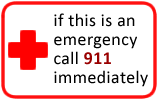Puncture Wound
Puncture Wound
Does this describe your symptoms? |
Click image for more info |
Definition
General Information
|
If not, see these topics
First Aid:FIRST AID Advice for Bleeding: Apply direct pressure to the entire wound with a clean cloth. FIRST AID Advice for Shock: Lie down with feet elevated. |
When to Call Your Doctor |
Call 911 Now (you may need an ambulance) If |
|
|
|
Call Your Doctor Now (night or day) If |
|
|
|
Call Your Doctor Within 24 Hours (between 9 am and 4 pm) If |
|
|
|
Call Your Doctor During Weekday Office Hours If |
|
|
|
Self Care at Home If |
|
|
HOME CARE ADVICE FOR MINOR PUNCTURE WOUND |
Cleansing: Wash the wound with soap and warm water for 15 minutes. For any dirt or debris, scrub the wound back and forth with a washcloth to remove it.
Trimming: Cut off any flaps of loose skin that seal the wound and interfere with drainage or removing debris. Use a fine scissors, after cleaning them with rubbing alcohol.
Antibiotic Ointment: Apply an antibiotic ointment and a Band-Aid to reduce the risk of infection. Re-soak the area and re-apply an antibiotic ointment every 12 hours for 2 days.
Pain Medicines:
For pain relief, take acetaminophen, ibuprofen, or naproxen.
Acetaminophen (e.g., Tylenol):
Take 650 mg by mouth every 4-6 hours. Each Regular Strength Tylenol pill has 325 mg of acetaminophen.
Another choice is to take 1,000 mg every 8 hours. Each Extra Strength Tylenol pill has 500 mg of acetaminophen.
The most you should take each day is 3,000 mg.
Ibuprofen (e.g., Motrin, Advil):
Take 400 mg by mouth every 6 hours.
Another choice is to take 600 mg by mouth every 8 hours.
Use the lowest amount that makes your pain feel better.
Naproxen (e.g., Aleve):
Take 250-500 mg by mouth every 12 hours.
Use the lowest amount that makes your pain feel better.
Extra Notes:
Acetaminophen is thought to be safer than ibuprofen or naproxen in people over 65 years old. Acetaminophen is in many OTC and prescription medicines. It might be in more than one medicine that you are taking. You need to be careful and not take an overdose. An acetaminophen overdose can hurt the liver.
Caution: Do not take acetaminophen if you have liver disease.
Caution: Do not take ibuprofen or naproxen if you have stomach problems, kidney disease, are pregnant, or have been told by your doctor to avoid this type of medicine. Do not take ibuprofen or naproxen for more than 7 days without consulting your doctor.
Before taking any medicine, read all the instructions on the package
Expected Course: Puncture wounds seal over in 1 to 2 hours. Pain should resolve within 2 days.
Call Your Doctor If:
Dirt in the wound persists after 15 minutes of scrubbing
It begins to look infected (redness, red streaks, tenderness, pus, fever)
Pain becomes severe
You become worse
And remember, contact your doctor if you develop any of the "Call Your Doctor" symptoms.
Updated:
March 22, 2017







